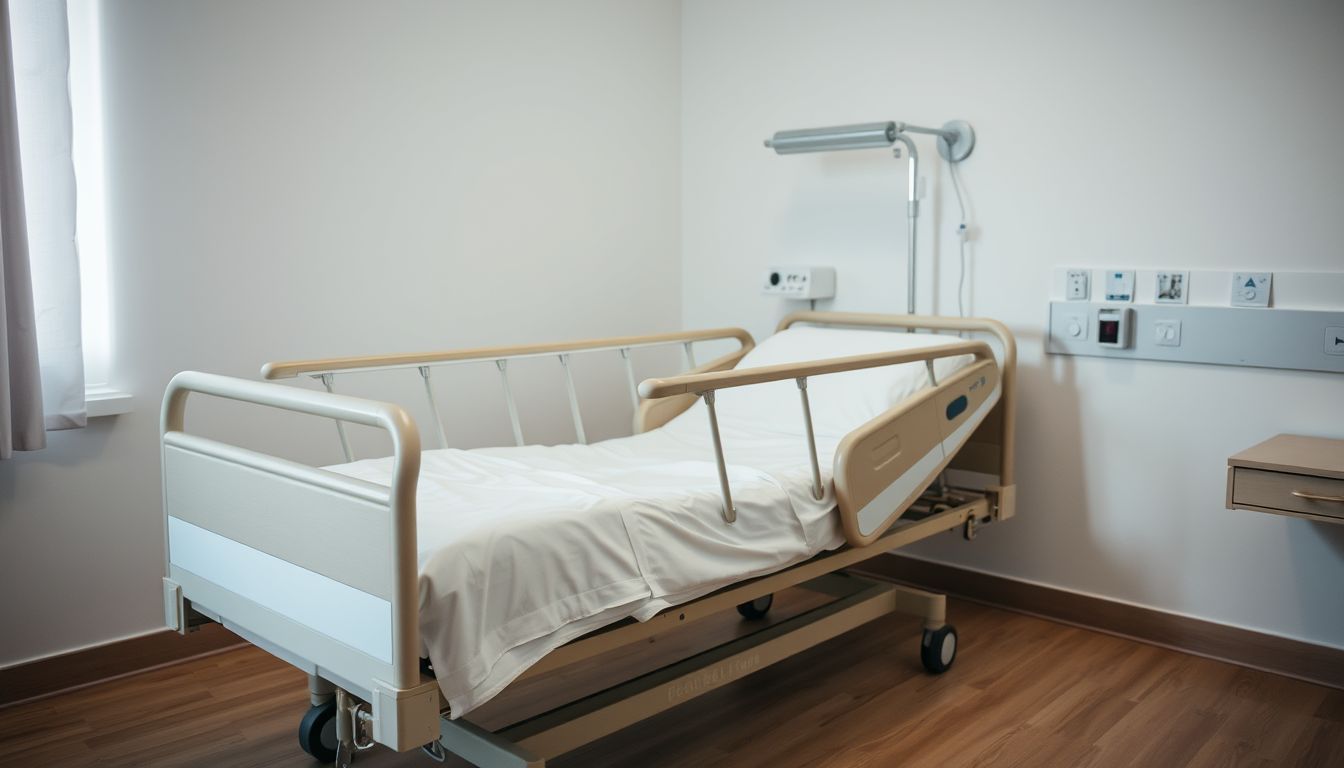Caring for patients is hard work. Adjustable beds make it easier. This article tells you how these beds help caregivers in big ways. Read on and learn more.
Key Takeaways
- Adjustable beds protect caregivers from getting hurt. They make moving patients safer. This means less back pain and fewer injuries for those who help care for others.
- These beds improve how caregivers do their jobs. They can change the bed’s position easily to help patients better. This makes tasks like preventing bedsores quicker and easier.
- Having adjustable beds saves money for hospitals and health homes in the long run. They cut down on costs related to caregiver injuries and extra patient care needs.
- Beds with special features match what each patient needs. This helps keep patients safe and comfy.
- Setting up a room right helps caregivers work well. Keeping tools close and using quiet, easy-to-move beds make caring for someone smoother.
Enhanced Caregiver Safety

Adjustable beds make moving patients safer, keeping caregivers from getting hurt. They help in avoiding back pain and strains during lifts.
Easier patient transfers
Moving patients from their beds to wheelchairs poses risks. Falls and injuries can happen. The Supernal 5 bed helps with this problem. It adjusts height from 12 inches to 24 inches, perfect for wheelchair moves.
This makes the job safer for both the patient and the caregiver.
The right tools make caregiving safer and more efficient.
With these beds, caregivers don’t have to bend or lift as much. This cuts down on their chance of getting hurt while working. Using beds like the Supernal 5 keeps everyone involved safe and comfortable.
Reduced risk of caregiver injury
Easier patient transfers lead to less risk for those who help them. Caregivers often hurt themselves helping patients stand up, especially if the bed and wheelchair heights do not match.
Adjustable beds fix this by letting caregivers change the bed’s height easily. This means less pulling and pushing, lowering injury chances.
These beds also have safety rails and customizable features that support the caregiver’s work. For example, they can adjust the bed for specific medical needs without straining their backs or shoulders.
This is crucial in avoiding long-term health problems from too much physical effort.
Improved Efficiency in Caregiving Tasks
Adjustable beds let caregivers move patients more easily. This helps them do their jobs faster and safer.
Adjustable positions for better patient access
Powered adjustments on beds make caring for patients easy. They let caregivers change head and foot levels without hard work. This helps get patients in and out of bed safely. It also lowers the chance of bedsores.
With these beds, finding the right spot for medical care gets simpler. For example, putting a patient in Fowler’s position eases breathing problems and acid reflux. Custom settings meet different care needs fast, boosting health outcomes.
Customizable features for specific care needs
After adjusting positions for better patient access, caregivers can use customizable features to meet specific care needs. Special mattresses like the PressureGuard® APM2 and the Supernal Sleep System help prevent bedsores.
They adjust air pressure or distribute weight to keep skin safe. These tools make caregiving easier and safer.
Advanced mattresses reduce pressure ulcers, making them essential for quality patient care.
Caregivers can change bed settings for patients with different conditions. For example, raising the head helps with sleep apnea and GERD by keeping airways open and stomach acid down.
This improves sleep quality and comfort without extra effort from caregivers or health care professionals.
Promoting Caregiver Comfort
Caregivers often face long hours and hard work. Adjustable beds ease their load, making care less tiring.
Reduced physical strain during long shifts
Long shifts are tough. Adjustable beds help a lot. They let caregivers move the bed up and down easily. This means less lifting and bending. So, their bodies don’t hurt as much. Also, powered adjustments do the hard work.
No more pulling or pushing to get patients comfy.
Caregivers feel better at work with these beds. They can stand and sit without strain for hours. Plus, changing bed heights helps them reach patients easier, no stretch or strain needed.
This keeps them ready to care without getting worn out fast.
Ergonomic benefits from adjustable bed features
Adjustable beds help caregivers move patients with ease. This cuts down on back pain from lifting or bending. Beds adjust to different positions, making tasks like feeding and cleaning simpler.
Caregivers do not have to strain as much during their shifts.
Adjustable hospital beds change position for each task, making care safer and less tiring.
These beds also offer settings that match the patient’s needs, such as elevating legs to reduce swelling or sitting up without needing extra pillows. This direct approach prevents injuries related to manual moves or adjustments.
Economic Benefits for Healthcare Settings
Adjustable beds save money for hospitals and care homes. They cut down on costs linked to caregiver injuries and patient care, making them a smart choice.
Cost-effective solutions for patient care
Medicare Part B can cover the cost of hospital beds that adjust if a doctor says it’s needed. This means caregivers can get these beds without huge costs. Prices for good mattresses for older people start at $899 and go up to $4,798.
Using adjustable beds saves money over time. They help avoid injuries to both patients and caregivers. Fewer injuries mean less money spent on healthcare services.
Adjustable beds also make caring tasks easier and quicker. This improves the quality of care without hiring more staff or buying lots of medical equipment. Caregivers can do more in less time, which is cost-effective for long-term care facilities and home hospice settings alike.
Long-term investment in caregiver health
Investing in caregivers’ health pays off. Adjustable beds help prevent injuries and lessen exhaustion. This means nurses and other healthcare workers stay healthier, lowering the need for sick days.
Happier staff leads to better care for patients.
Adjustable beds also mean savings for hospitals and care facilities. Less worker injury reduces insurance costs. Over time, this investment makes more sense than spending on short-term fixes that don’t last.
Caregivers can do their jobs without hurting themselves, making it a smart choice for everyone involved.
Best Bedroom Setups for Caregivers
Caregivers need smart bedroom setups to do their job well. Good setups help both the patient and the caregiver. Here’s a list:
- Place the adjustable bed near the door. This makes entering and leaving easy without disturbing the patient much.
- Keep necessary tools close, like remote controls for the bed, stand assist chairs, and CPAP machines. This saves time and reduces walking.
- Use beds with features that suit the patient’s needs—like memory foam for pressure relief or beds that tilt for those with respiratory issues.
- Set up good lighting. Place lamps where they can light up dark corners but won’t bother the patient’s sleep.
- Organize a small table or shelf within arm’s reach of the bed for medicines, water, and snacks.
- Choose beds with quiet motors. This way, adjustments don’t wake up or disturb patients during rest.
- Install safety rails on beds to prevent falls. Make sure they are easy to move when transferring patients.
- Arrange for enough space around the bed so caregivers can move freely and use tools like wheelchairs or walkers easily.
- Provide comfortable seating near the bed for long periods of care or observation.
- Include personal items that make patients feel at home—photos, books, or music players—to improve mental health beside physical care.
Good setups support efficient care giving and comfort making tough jobs a bit easier for everyone involved.
Conclusion
Adjustable beds make caregiving safer and easier. They help avoid injuries by making it simpler to move patients. These beds also save time with their features, like remote controls for quick adjustments.
For caregivers working long hours, these beds cut down on physical stress. Finally, they are a smart choice for saving money in medical settings over time.
For more detailed information on how to create an optimal care environment, check out our guide on the best bedroom setups for caregivers.
FAQs
1. What are the health benefits of adjustable beds for caregivers?
Adjustable beds can provide relief from conditions like snoring, respiratory problems, and gastroesophageal reflux disease (GERD). They also aid in pain management and control, offering relief from aches and pains.
2. Can adjustable beds improve quality of life for those with mobility issues?
Absolutely! Adjustable beds help those with mobility issues by providing ease in getting in and out of bed. This can lead to healthier living, improved sleep disorders such as insomnia, and reduced hospitalization rates.
3. How do adjustable beds assist postoperative care?
Following surgeries or physical therapy sessions, an adjustable bed allows patients to rest comfortably in Fowler’s position or zero-gravity positions which aids recovery while reducing fatigue and edema especially in lower extremities.
4. Are there mental health benefits linked with using adjustable beds?
Yes indeed! Quality sleep is essential for mental well-being… Adjustable beds offer better sleep-tracking features that combat sleep-related disorders leading to less stress on caretakers too!
5. Does Medicare cover the cost of an adjustable bed if it’s recommended by healthcare providers?
It depends on specific circumstances… For detailed information about coverage for items like this under your plan, refer directly to medicare.gov or consult your health services provider.
6. Can having an adjustable bed at home reduce caregiver burnout?
Definitely! By improving patient comfort—especially among elderly care recipients—and making tasks easier for caregivers; these innovative solutions contribute significantly towards aging-in-place strategies thus preventing caregiver burnout.









